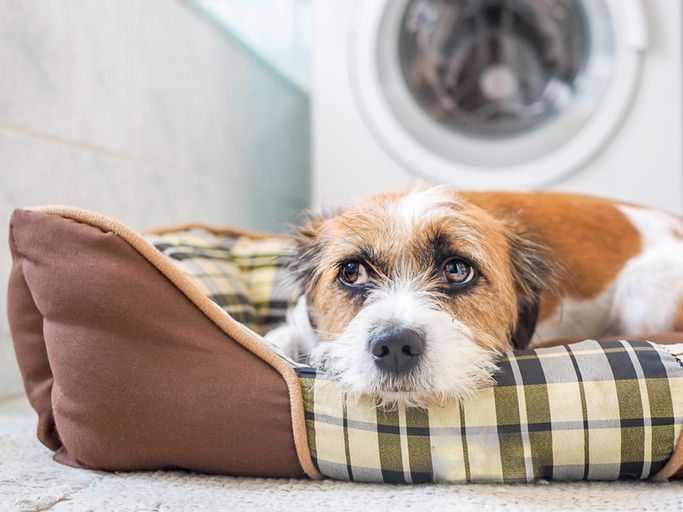Of all the various sound sensitivities we encounter with our dogs, thunder phobias might be the worst – hardest to predict and manage, and most challenging to modify. Having had several storm-sensitive dogs over the years myself, I can commiserate with anyone living with a dog that’s scared of thunder and who freaks out at storms.
What Does Storm Sensitivity Look Like?
Dogs who are fearful of storms may display one or more of a long list of anxiety behaviors, including:
- Pacing
- Panting
- Trembling
- Hiding
- Clinging to owner
- Drooling
- Destructiveness
- Excessive vocalization
- Self-inflicted injury
- Incontinence
The sooner you recognize these behaviors and take steps to manage your dog’s storm stress, the better. Storm phobias tend to get significantly worse if not addressed quickly.
Managing a Dog Scared of Thunder
If you can, create a safe place in your home where it’s possible to muffle or mute storm sounds, such as a well-insulated basement. You can also utilize so-called “sound-proof crate covers” (a heavy moving blanket will work), noise-blocking curtains, and/or sheets of sound-absorbing material, and use a white noise machine or calming music to muffle storm sounds.
There are also a number of over-the-counter products that can help reduce storm stress, such as the Thunder Shirt; calming pheromones like Adaptil diffusers, collars, and sprays; and anxiety-relieving nutritional supplements. Ask your veterinarian which of these they would recommend.
Additionally, this is one of the few behaviors for which I urge clients to discuss prescription anti-anxiety medications with a veterinarian who is knowledgeable about behavior or a veterinary behaviorist, sooner rather than later. Be sure to ask about Sileo – the first and only FDA-approved noise-aversion medication for dogs.
Modifying Storm Sensitivity
Because thunder-phobic dogs come to associate the approach of a storm with the inevitable arrival of thunder and lightning, they tend to become more and more sensitized to the mere hint of a potential storm – dark clouds, increasing wind and, some suggest, change in barometric pressure. Counter-conditioning and desensitization (CC&D) is one of our most useful tools for changing a dog’s association with a fear-causing stimulus.
One of the key elements of a successful CC&D program is the ability to control the intensity of the aversive stimulus – distance, volume, amount of movement – hence the challenge with storms. We cannot control how loud, intense, windy, or close a storm will be, and we can’t control when or where lightning will strike. Recordings of storms may be helpful for CC&D, but many dogs can easily tell the difference between a recording and a real storm. For help choosing an effective recording of a storm to use for CC&D, see “Sound Effects,” WDJ March 2020.
You can do CC&D with treats, and will need to stop treating when your dog becomes too stressed to eat. Some owners successfully use play for CC&D – engaging the dog enthusiastically in a favorite game at the first sign of pending storm activity. This can help – but it risks giving the dog a negative association with her favorite games. Use play carefully, and end the game before your dog is so stressed she shuts down and stops playing. See this article for in-depth information about how to use CC&D to help a storm-phobic dog.
Finally, it is perfectly appropriate to comfort your storm phobic dog. Despite warnings you may have heard, you cannot reinforce fear, and your calm reassurances can help your dog through these hard times.
It’s not easy living with a storm-phobic dog, and the road will be long. Speaking from experience, I can tell you that it’s well worth it when you can finally see your dog resting peacefully at your feet while that storm rages overhead.






